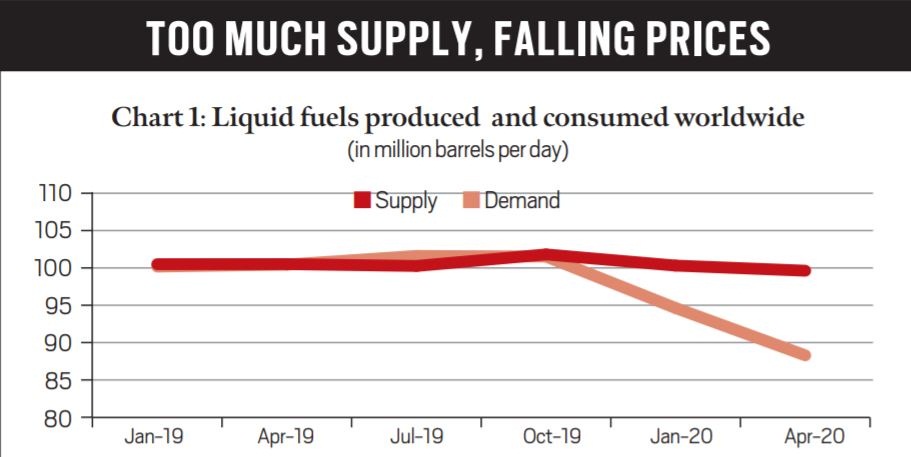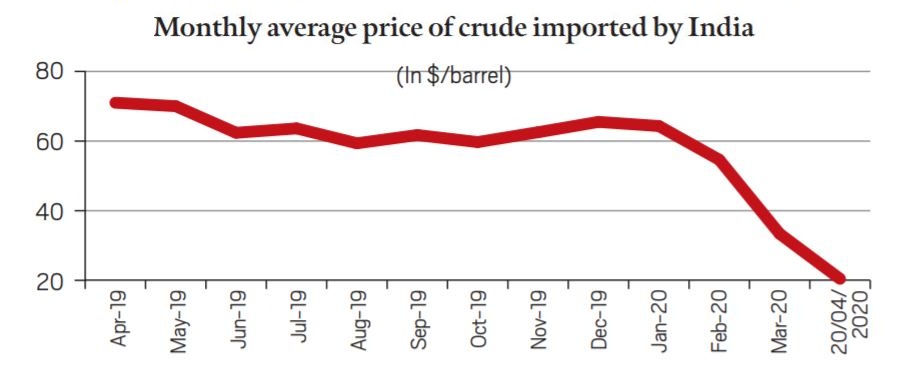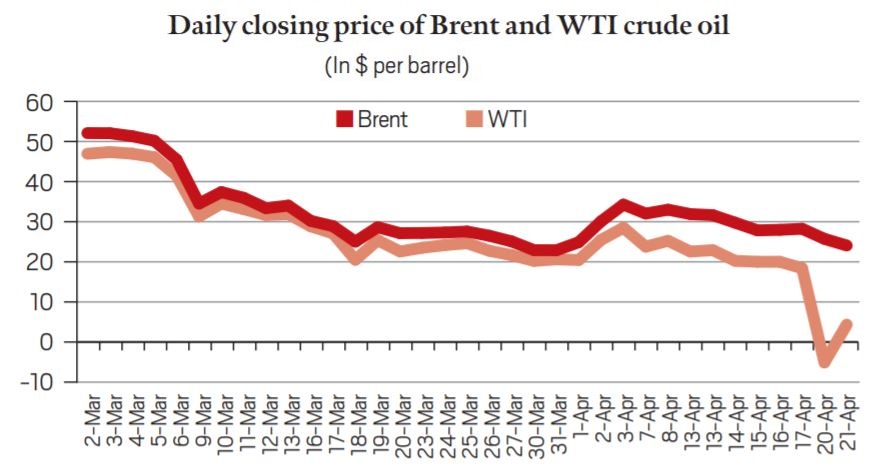Economy
Oil Prices Below Zero
- 22 Apr 2020
- 8 min read
Why in News
Recently, the prices of West Texas Intermediate (WTI), the best quality of crude oil in the world, fell to minus $40.32 a barrel in interlay trade in New York (the USA).
- It means that the seller of crude oil would be paying the buyer $40 for each barrel that is bought.
- It is the lowest crude oil price ever recorded below the zero mark while the previous lowest was recorded immediately after World War II (WWII).
Oil Pricing
- Generally the Organization of the Petroleum Exporting Countries (OPEC) used to work as a cartel and fix prices in a favourable band.
- OPEC is led by Saudi Arabia, which is the largest exporter of crude oil in the world (single-handedly exporting 10% of the global demand).
- It could bring down prices by increasing oil production and raise prices by cutting production.
- The global oil pricing mainly depends upon the partnership between the global oil exporters instead of well-functioning competition.
- Cutting oil production or completely shutting down an oil well is a difficult decision, because restarting it is immensely costly and complicated.
- Moreover, if a country cuts production, it risks losing market share if other countries do not follow the suit.
- Recently, OPEC has been working with Russia, as OPEC+ to fix the global prices and supply.
Reasons for Price Fall
- Crude oil prices were already falling before the global lockdown due to the higher supply and lower demand.
- They were close to $60 a barrel at the start of 2020 and, by March-end, they were closer to $20 a barrel.
- Problems arose when Saudi Arabia and Russia disagreed over the production cuts, required to keep prices stable.
- Consequently, Saudi Arabia led oil-exporting countries started undercutting each other on price while producing the same quantities of oil.
- This strategy was unsustainable on its own and the global spread of Covid-19 made it even worse as it sharply reduced the economic activity and the oil-demand.
- Oil-exporting countries decided to cut production by 10 million barrels a day (the highest production cuts) and yet the demand for oil was reducing even further.
- This supply demand mismatch resulted in exhausted storage capacities.
- It is important to highlight that the US became the largest producer of crude oil in 2018 and the current US President has been pushing for higher oil prices instead of making efforts for lower prices like the previous US Presidents.
- The oil prices started falling steeply because the May contracts for WTI were due to expire on 21st April, 2020 which posed huge challenges for both the oil producers and the consumers (contractors/buyers).
- Producers: They started selling the oil at unbelievably low prices because shutting production would have been costlier to restart when compared to the marginal loss on May sales.
- Consumers: They were facing the problem of storage. There is no space to store the oil even if they decided to buy and take the delivery.
- Accepting the oil delivery, paying for the transportation and storage would have been costlier than the hit on contract price.
- In the short term, for both the holders of the delivery contract and the oil producers, it was less costly to pay $40 a barrel and get rid of the oil instead of storing it (consumers/buyers) or stopping production (producers). So this led to the negative WTI oil contract prices.
Future of Oil Prices
- It was the WTI price for May in the US markets that went so low. Crude oil prices at other places fell but not too much.
- Prices for June and the coming months are pegged between $20 and $35 a barrel.
- Investment budgets of exploration and production companies are expected to drop because of the low shale oil prices.
- Normally, this should force oil exporting countries to cut back production and negate the excess supply, restoring balance in the oil markets but the possibility of recent events from happening again cannot be ruled out.
- Eventually, it would be the demand-supply mismatch (adjusted for how much can be stored away) that will decide the fate of oil prices.
Impact on India
- There is no direct impact on India because Indian crude oil basket does not comprise WTI and it only has Brent and oil from some of the Gulf countries.
- However, the weakness in WTI reflects on the falling prices of Indian basket as well because oil is traded globally and has indirect impacts.
- The lower price can be beneficial for India in two ways:
- For Individuals: If the government passes on the lower prices to consumers, then individual consumption will be boosted whenever the economic recovery starts in India.
- For Governments: If both, central and the state, governments decide to levy higher taxes on oil, it can boost government revenues.
Difference between Brent and WTI
- Brent crude oil originates from oil fields in the North Sea between the Shetland Islands and Norway, while West Texas Intermediate (WTI) is sourced from US oil fields, primarily in Texas, Louisiana, and North Dakota.
- WTI with a lower sulphur content (0.24%) than Brent (0.37%), is considered "sweeter".
- Both oils are relatively light, but Brent has a slightly higher API gravity, making WTI the lighter of the two.
- American Petroleum Institute (API) gravity is an indicator of the density of crude oil or refined products.
- Brent crude price is the international benchmark price used by the OPEC while WTI crude price is a benchmark for US oil prices.
- Since India imports primarily from OPEC countries, Brent is the benchmark for oil prices in India.
- Cost of shipping for Brent crude is typically lower, since it is produced near the sea and it can be put on ships immediately. Shipping of WTI is priced higher since it is produced in landlocked areas like Cushing, Oklahoma where the storage facilities are limited.








-min.jpg)